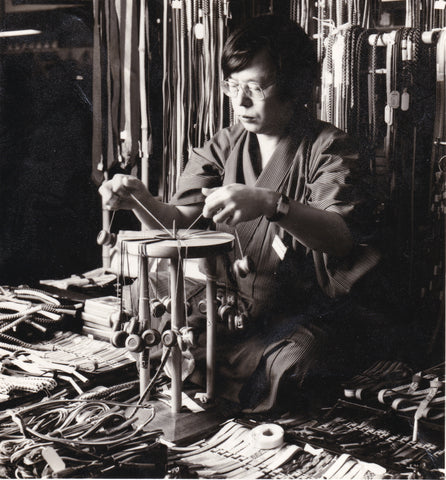Edo Kumihimo by Kiryudo
Kumihimo for Edo
The history of our business, Kiryudo, began in 1876. The Civil War brought the company to Edo (old Tokyo) from Kiryu City in Gunma Prefecture, a famous raw silk production center in the Kanto region.
Edo was an indispensable part of the daily life of Kumihimo (traditional Japanese braided cords). During the Edo period (1603–1867), warriors tied swords around their waists in many samurai residences. After the sword prohibition, the demand for Kumihimo as a cord for hanging swords decreased.
The demand for Kumihimo as an Obijime (Kimono sash fastener) was revived when geisha invented a new way of tying obis using Kumihimo called Odaikomusubi (a belt knot). As the custom of wearing Haori (traditional jackets) spread among the general public, they were also used to fasten the front part of Haori. It became an indispensable part of daily life.

Haori Cords with Kinpai Seals
When Kiryudo was first established, it specialized in making pocket watch cords. However, demand for Obijime and Haori cords made with Kumihimo increased. By the Taisho era (1912–1926), making men's Haori cords became the company's main product. The company's trademark was changed to the Kinpai mark when it won the gold medal for Haori cords at the National Industrial Exhibition Held in Tokyo's Ueno area.During the Taisho era, products made from raw silk were one of Japan's major industries, but after World War II, people no longer wore kimonos due to westernization. As a result, the number of Edo Kumihimo makers fell. Some went out of business, while others relocated to the Kansai region (Western Japan), where kimono culture was more prevalent.


Quality Kumihimo, Even as Times Change

The Artisans of Kiryudo
The number of Kumihimo artisans is decreasing each year. The techniques handed down for a long time are disappearing with the passing of each master. Currently, the fifth and sixth generations of the Haneda family carry on the tradition. In addition, three Kumiko (apprentice Kumihimo artisans) are presently in training.
Shinji Haneda V
- Chairman of Edo Kumihimo Traditions Association (former Tokyo Obijime Industry Cooperative)
- Former head of Tokyo Kumihimo Itohokai (former Tokyo Kumihimo Wholesale Cooperative)
- Former chairman of the National Obijime Haoribimo Fair Trade Council

My mission is to pass on and develop the technique. A cord that can be tied with light force and does not loosen. When you want to untie it, it is easy to do so. I would like to pass on the world of Kumihimo while conveying its quality.
Yuji Haneda VI
- Studied under his father and Mr. Hiroyuki Kondo, a Tokyo Metropolitan Traditional Craftsman
- Member of Japan Traditional Crafts Art Association

My grandfather and father often told me growing up to go off the beaten path. The speed of the world and the landscape are entirely different from the past, and I feel it is impossible to continue simply by adhering to traditional techniques. It is no good to be too innovative, but I dare not go against the flow of the times.

